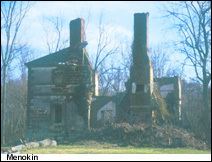Area 590 acres (240 ha) Architectural style Georgian VLR # 079-0011 Phone +1 804-333-1776 | Built 1769 NRHP Reference # 69000276 Opened 1769 | |
 | ||
Address 4037 Menokin Rd, Warsaw, VA 22572, USA Hours Closed now Saturday12–4PMSundayClosedMondayClosedTuesdayClosedWednesday10AM–4PMThursday10AM–4PMFriday10AM–4PM Similar Mount Airy, Stratford Hall, George Washington Birthplac, Belle Mount Vineyards, Sabine Hall Profiles | ||
Menokin the most engaging preservation project in america
Menokin, also known as Francis Lightfoot Lee House, was the plantation of Francis Lightfoot Lee near Warsaw, Virginia. Lee was a signer of the United States Declaration of Independence. Menokin was declared a National Historic Landmark in 1971.
Contents
- Menokin the most engaging preservation project in america
- Menokin speaker series dr richard s dunn
- Native American settlement
- Construction of Menokin and subsequent decline
- Francis Lightfoot Lee
- Architectural significance
- Timeline
- References
Historic American Buildings Survey (HABS) documentation, including photos from the 1940s, shows the house standing and reported that it was in poor condition, awaiting a restorer. The National Park Service webpage shows the house in ruins, but reports that woodwork had been removed and placed in storage in the 1960s. Although the house has partly collapsed, the Menokin Foundation has developed a plan to restore the house using glass segments to fill missing portions of the building instead of trying to restore the house to its original condition.
Menokin speaker series dr richard s dunn
Native American settlement
Before the Menokin plantation was ever developed, this area along Cat Point Creek (also called Rappahannock Creek) was home to the Rappahannock Indian Tribe. In 1608, Capt. John Smith explored the creeks that feed into the Rappahannock River and recorded his meetings with the Rappahannocks, which gives us a written glimpse into the area and its people at that time. The general plantation site was referred to as "Menokin" by the Rappahannocks, which likely translates to "He gives it to me" in their Algonquian-based language. Francis Lightfoot Lee kept the name for his home.
Construction of Menokin and subsequent decline
Menokin was built c. 1769 on the occasion of the marriage of Francis Lightfoot Lee and Rebecca Tayloe. Rebecca was the daughter of John Tayloe II, who built neighboring Mount Airy. John Tayloe II gave the couple the large plantation on Cat Point Creek, approximately five miles upstream from the Rappahannock River, and financed construction of the two-story stone Menokin and its dependencies. Soon after, Francis Lightfoot Lee joined the cause of American independence, serving in the Continental Congress from 1775 to 1779 and signing the Declaration of Independence (together with his brother Richard Henry Lee) and the Articles of Confederation. Both Francis Lightfoot and Rebecca Tayloe Lee died in the winter of 1797. Menokin was then owned by Rebecca's nephew John Tayloe III, who lived at Mt. Airy and later built the Octagon House in Washington, D.C. Between 1809 and 1819, John Tayloe Lomax lived at Menokin with his family. Lomax would later become the first Professor of Law at the University of Virginia. During the 19th and 20th centuries, Menokin passed hands several times and went into serious decline around 1935 when it lay, for the most part, vacant before coming into possession of The Menokin Foundation in 1995.
Francis Lightfoot Lee
The full story of Francis Lightfoot Lee, and the mark that he made on both the Commonwealth of Virginia and the developing United States of America has not been told. Bits and pieces come from many sources: his letters, letters about him, comments by friends and relatives, and the fact that he was a signer of both the Westmoreland Resolves (February 27, 1766) and the Declaration of Independence (1776). He served in the Virginia House of Burgesses, first from Loudoun, and then from Richmond County. He was in Philadelphia in 1776 as a Virginia delegate to the second Continental Congress, returning to Virginia in 1779. He served briefly in the Viate after that, but for the most part he was content to be at home at Menokin with his books and his farm and his beloved wife, Becky Tayloe. Research concerning the life and work of Francis Lightfoot Lee is an ongoing project of the Menokin Foundation.
Architectural significance
Although Menokin is now in ruin, a remarkable collection of Colonial architectural elements remains. Approximately 80 percent of Menokin's original materials have survived, including: original stones, brick and mortar; queen posts and dragon beams; intact framing assemblages; and the interior woodwork. In 1940, while the house and one outbuilding were still standing, the Historic American Buildings Survey produced detailed photography and comprehensive measured drawings of the property. In 1964, the original pen and ink presentation drawings for Menokin were discovered among some Tayloe family papers in the attic of Mount Airy . Four years later, as the house was in serious trouble of collapsing, the interior woodwork was removed by the owner and put into storage. The surprisingly intact woodwork is back at Menokin and can be viewed at the Foundation's King Conservation and Visitors Center . Menokin's dining room paneling is on loan to the Virginia Historical Society where it is now on display. In 1971, Menokin was designated a National Historic Landmark by the U.S. Department of the Interior.
